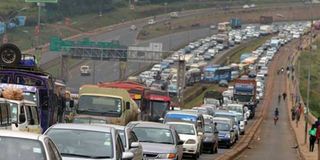Non-time based traffic lights planned to ease Nairobi gridlock

Motorists held up in a traffic jam on Thika Road in Nairobi. FILE PHOTO | WILLIAM OERI | NATION MEDIA GROUP
What you need to know:
- NTSA says that with new number plates that will have microchips, the cameras at intersections will be able to determine the most clogged roads.
The transport regulator is working to introduce intelligent traffic lights that will allow a longer period of traffic flow from roads with most vehicles, a departure from the current time-based system.
The National Transport and Safety Authority (NTSA) says that with new number plates that will have microchips, the cameras at intersections will be able to determine the most clogged roads.
Traffic lights currently allocate an equal amount of time for traffic from different directions at intersections, while at other junctions vehicle flow is controlled by police officers.
“When you have the cameras that can tell a specific side of the roads needs to be decongested — the right, for example, has a 100 vehicles and the left has five — it will automatically allow the one with more vehicles,” Fernando Wangila, ICT director at the authority said.
He added that the agency is working to put data on all vehicles into a database that will then be linked to the traffic lights, making it possible to introduce such intelligent systems to decongest the roads.
The smart traffic flow will be part of a Sh800 million online platform dubbed the Transport Integrated Management Systems developed by the NTSA and the ICT Authority.
The time-based traffic lights allow for equal amounts of time and that is seen to clog the roads that have more vehicles.
This has made the lights inefficient during peak traffic hours, with police officers taking over control of vehicle flow.
Mr Wangila said police play a small part in adding to the jams by keeping cars on certain lanes longer at traffic intersections though those lanes have more vehicles than others.
The NTSA recently released regulations for new number plates that will come with a microchip that can be read remotely by sensors at the junctions.
The radio frequency identification microchip will be embedded on a sticker placed on the windscreen to facilitate wireless transfer of information between it and mobile police readers or at traffic lights.
Previous attempts to get the traffic lights fully control vehicle flow in Nairobi have failed despite substantial investments in the systems.
City Hall spent Sh400 million to install new traffic lights and cameras in Nairobi in 2014, but the lights are used only at a few junctions after they were deemed ineffective for the task.
A later plan to replace roundabouts with signalised intersections that would be fully controlled by traffic lights was also shelved.
By the end of 2014, Kenya had about 2.2 million vehicles, including motorcycles, with a substantial portion of these in Nairobi and its satellite towns.
The World Bank, in a recent report, said Nairobi residents on average spend an hour to travel to work and another 60 minutes commuting back home due to heavy traffic congestion on the city's roads.
- From the Business Daily




